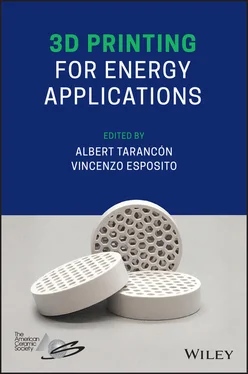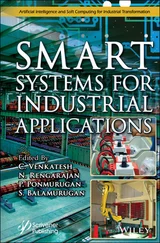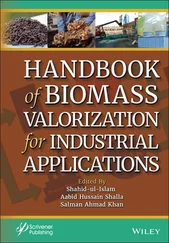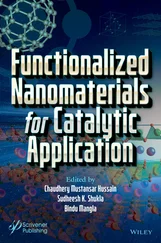1 ...6 7 8 10 11 12 ...17
1.1.2 Geometrical Gradients in AM
AM lends increased design freedom for the manufacturing of unique functional geometries. Hegab [15] reviewed the design aspects of geometrically graded functional materials. These range from rudimentary component optimization through integrated component design, to flexures, engineered to form compliant mechanisms that are constrained in specific degrees of freedom. The ease by which metamaterials can be manufactured from a highly engineered and well‐defined unit cell enables the construction of filters, membranes as well as light and stiff components where the uncertainty from using a stochastic manufacturing method such as foamed materials is taken out of the equation. Said metamaterials can be designed using topology optimization, also known as generative design, to functionally grade a component toward a specific wanted behavior such as thermal conductivity or elastic deformation. The above‐mentioned capabilities enable AM to be strategically employed to induce added functionality of a part. For example, how a load‐bearing part will buckle and deform and eventually collapse plastically can be precisely be achieved by a combination of integrated component design, compliant mechanisms, and topology optimized metamaterial gradient. The performance of geometrically graded AM parts depends on the voxel size, which in turn determines the limits to physical complexity. Hence, AM processes with smaller voxels, namely powder bed fusion ( Section 1.2) and sintering‐based hybrid AM ( Section 1.5), have the best applications of geometrical gradation.
1.1.3 Material Gradients in AM
Traditional manufacturing processes start typically from one feedstock and then convert it into the desired shape. AM processes on account of being a selective consolidation based manufacturing processes offer tremendous flexibility in functional material gradients. Naebe & Shirvanimoghaddam [16] reviewed functionally graded components manufactured through different methods and showcased the importance of AM for expanding the scope and application of functional components. Loh, Pei, Harrison, and Monzón [17] reviewed functionally graded AM components and showed that material gradation was currently only limited by AM process tool design. Rafiee, Farahani, and Therriault [18] reviewed various multi‐material additive manufacturing methodologies and found that certain AM processes are better at combining multiple materials than others. Extrusion based additive manufacturing ( Section 1.5) is an example where the pointwise deposition of extrudate constitutes the workpiece, and complete control of the extrude through a mixing extruder allows for a multitude of materials to be dynamically blended and deposited [19]. Likewise, direct energy deposition ( Section 1.3) allows for graded interfaces due to in‐situ powder mixing and hence allows for pointwise grading of the materials while minimizing the waste generated throughout the process [20]. In the case of powder‐bed technologies ( Section 1.2) and vat photopolymerization AM (VPAM) technologies ( Section 1.5), cross contamination of the feedstock materials induces the risk of a waste/component ratio where the waste product is the larger output. This can be remedied by ensuring that the build envelope is packed as densely as possible and improvements to the AM process are necessary to encourage wider adoption of material gradients in these technologies. Solid‐state AM is uniquely suited for multiple materials due to the low‐temperature processing capability that eliminates typical problems with melting and solidification ( Section 1.4).
The following sections focus on one class of AM process each and dive into the potential for functional metal AM components.
Powder bed fusion (PBF) refers to a class of AM processes. The most common machine tool for metal additive manufacturing is the PBF systems. This type of machine operates by selectively fusing powder following a layer‐by‐layer deposition principle. The powder is contained in a silo and fed to a re‐coater to evenly distributed powder between consolidation operations. The tool distributing the powder can be in the form of a scraper, a roller, or a blade that is designed to both fluidize and distribute the powder. As this tool has a major influence on the distribution of the layer, the powder and the tool have to be carefully matched to the application. Two kinds of PBF technologies are based on the laser (L‐PBF) and the electron‐beam (EB‐PBF) as the power source [21]. The L‐PBF process is more versatile since it can operate under a neutral gas atmosphere while EB‐PBF requires a vacuum. However, electron beams are faster and can be controlled efficiently through magnetic mirrors and hence offer certain advantages. The high‐density parts and small voxel size distinguish powder bed fusion from other metal AM processes for manufacturing functional components. In the past 20 years, PBF technologies (especially L‐PBF) have seen a rapid increase across various sectors, such as aerospace, biomedical, tooling, and energy sectors [3]. Several review articles discuss PBF process–structure–property relations and establish applications for Type‐I functional materials [22, 23]. A much smaller portion of the literature is focused on more complex functionally gradient metal PBF. Design of functionally gradient additive manufacturing (FGAM) components encompasses distributed site‐specific properties with gradual transitions in geometry, chemical compositions, constituents, or microstructures. A lack of guidelines on the selection and distribution of materials has hindered the development of FGAM, thereby limiting the microstructural design and arrangement of transition phases. Although some commercial software packages exist for FGM's and multi‐materials 3D printing, they are still far removed from real industrial applications and the ever‐increasing demands of novel functionally graded components. FGAM of PBF is a highly underexplored field for metals, especially in the material gradients domain. An overview of the literature on metal PBF functional components is presented in the following sections according to geometrical and material gradients.
1.2.1 Geometric Gradients in PBF
Porous metals in various forms, including foams and lattices, have been investigated for many years for a wide variety of applications [24, 25]. These range from lightweight structures to functional applications such as heat exchangers or electrodes. Cellular solids have been investigated to determine relationships between their geometry and their physical properties (thermo‐mechanical, acoustic, impact‐toughness, etc.). The motivation for much of this research is high‐performance applications; for example, in simultaneous structural light‐weighting and sound dampening in motor vehicles/aircraft, thus providing high functionality with minimized resource consumption. Recent advances in lattice design have enabled the creation of structures with spatially varying solid volume fraction; these are termed as functionally graded lattices. Gibson‐Ashby models have developed a theoretical framework for cellular lattice materials that are well suited for generating topology optimized designs. Powder bed fusion systems are uniquely suitable to manufacture the highly complex lattice structures with struts as small as 100 μm.
Maskery et al. [26] investigated the mechanical properties of graded density Al‐Si10‐Mg lattice structures manufactured by L‐PBF for structural applications and found significant improvement in compressive and impact strength. Choy, Sun, Leong, and Wei [27] showed similar improvements in mechanical properties for Ti‐6Al‐4V. Li, Hassanin, H., Attallah, Adkins, and Essa [28], and Tan et al. [29] investigated TiNi Shape Memory Alloys (SMA) fabricated by L‐PBF. The process conditions that lead to the microstructural characteristics play a major role in the SMA alloy properties. L‐PBF of TiNi lattices can enable tailored properties, in addition to the functionality associated with the shape‐memory effect. Li et al. [28] used a topology optimized design to manufacture a negative Poissons ratio metamaterial.
Читать дальше












